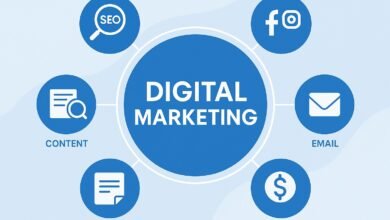Understanding B2B and B2C: Benefits and How They Work

Introduction to B2B and B2C
In the realm of commerce, two prominent models exist that drive the flow of goods and services: Business-to-Business (B2B) and Business-to-Consumer (B2C). These frameworks define the relationships between different parties involved in the commercial transaction process. B2B pertains to transactions that occur between businesses. In this model, one business sells products or services to another, often requiring complex negotiation processes, longer sales cycles, and a focus on building lasting relationships. Such transactions may include wholesale distribution, software solutions, or professional services tailored to meet the needs of companies.
Conversely, B2C represents the relationship where businesses sell directly to individual consumers. This model capitalizes on emotional decision-making, targeting customers through marketing strategies that focus on a wide audience. Retail, e-commerce, and subscription services are typical examples of B2C interactions, where ease of purchasing, brand loyalty, and customer satisfaction play critical roles. The primary distinction between these two models lies in their target markets; B2B exchanges focus on other businesses, while B2C caters to individual buyers.
The significance of understanding B2B and B2C in the modern economy cannot be overstated. Both models play vital roles in fueling economic activity and fostering innovation. B2B transactions often yield larger order volumes and long-term contracts, contributing to steady revenue streams for companies. B2C engagements, on the other hand, drive consumer spending, influence market trends, and shape brands. As businesses navigate an increasingly digital landscape, the lines between B2B and B2C continue to blur, raising important considerations for organizations looking to optimize their operations and effectively serve their target audiences.
Key Characteristics of B2B and B2C
The business landscape primarily consists of two fundamental models: Business-to-Business (B2B) and Business-to-Consumer (B2C). Understanding the key characteristics of each is essential for anyone looking to navigate these markets effectively. One of the most distinguishing factors is the target audience; B2B models typically focus on other businesses as their clients, while B2C targets individual consumers. This fundamental difference drives various aspects in how these businesses operate.
Transaction sizes also vary significantly between B2B and B2C models. In B2B transactions, the amounts are often larger and involve bulk purchases, as companies seek to fulfill operational needs or resell products. Conversely, B2C transactions are generally smaller, as they cater to individual customers purchasing items for personal use. This difference can influence pricing strategies and sales tactics, leading B2B companies to offer more bulk discounts and tailored packages, while B2C firms may emphasize promotional deals and consumer incentives.
Purchasing behavior represents another critical distinction. B2B purchasing decisions often involve multiple stakeholders and extensive research, as businesses evaluate products on the basis of cost-effectiveness and long-term value. B2C purchasing, on the other hand, tends to be quicker and is often driven by emotional factors. Consumers may make purchasing decisions impulsively, influenced by advertising, brand loyalty, or current trends.
Furthermore, customer relationships in B2B generally involve long-term partnerships and ongoing communication, leading to a focus on building trust and reliability. B2C relationships, however, tend to be more transactional, with companies emphasizing brand experience and customer satisfaction to encourage repeat business. Finally, the typical sales cycle demonstrates considerable differences; B2B sales cycles can span months or even years due to the complexity of transactions, whereas B2C cycles are typically much shorter, aligning with the immediate needs of consumers.
Benefits of B2B: How Businesses Gain
In the competitive landscape of modern commerce, B2B (business-to-business) relationships offer a myriad of advantages that are instrumental in fostering sustainable growth and efficiency. One of the fundamental benefits of B2B transactions is the establishment of long-term partnerships. Companies engaging in B2B relationships can cultivate trust and rely on one another for consistent supply and support, leading to greater stability in operations and financial forecasting.
Moreover, businesses participating in B2B modalities often enjoy the benefits of bulk purchasing. By purchasing in larger quantities, B2B entities can negotiate better pricing and receive discounts, significantly reducing overall costs. This is particularly advantageous for businesses looking to manage their budgets effectively while ensuring a steady stream of inventory. For instance, a manufacturing company sourcing raw materials from a supplier can achieve considerable savings through bulk orders, enhancing their bottom line.
Specialized services tailored to the needs of businesses are another critical aspect of B2B advantages. Many B2B suppliers offer customized solutions, which can range from specialized product features to tailored support services that enhance the functionality of the goods provided. This level of customization can boost efficiency and productivity for businesses, allowing them to focus on their core operations without the distraction of logistical complexities.
Furthermore, B2B relationships often lead to streamlined processes and improved communication. By establishing direct channels of interaction, businesses can facilitate quicker decision-making and problem resolution. Real-world examples abound, with companies like Shopify and Salesforce demonstrating how B2B platforms can enhance operational efficiencies, allowing businesses to scale their operations seamlessly. In essence, the B2B model not only provides financial incentives but also fosters a collaborative environment that drives innovation and growth.
Benefits of B2C: How Consumers Win
Business-to-consumer (B2C) models offer numerous advantages to consumers, reshaping the way they shop and interact with brands. A primary benefit is convenience, as B2C companies often provide online platforms that allow consumers to shop from the comfort of their homes. This accessibility reduces the need for physical trips to stores, which can be especially beneficial for busy individuals or those with mobility challenges.
Another significant advantage of B2C enterprises is the variety they offer. These businesses frequently have extensive inventories, allowing consumers to select from a wide range of products and services. This diverse selection not only satisfies unique preferences but also empowers consumers to make informed decisions based on their specific needs. Additionally, the competitive pricing structures commonly found in B2C environments encourage price comparisons, ensuring that consumers are more likely to find the best deals.
Personalized marketing is another crucial element of the B2C model. By leveraging data analytics and customer insights, B2C businesses can tailor their advertising and promotional strategies to suit individual preferences. This approach enhances the shopping experience, as consumers receive relevant product recommendations, personalized offers, and targeted communications that align with their interests, leading to increased satisfaction.
Moreover, improved customer support is a hallmark of B2C transactions. Many businesses recognize the importance of exceptional service and invest in user-friendly customer service solutions. This includes chatbots, dedicated helplines, and comprehensive online FAQs that address consumer inquiries promptly and effectively. As a result, consumers benefit from immediate assistance and resolution of their issues, ensuring a smooth shopping experience from start to finish.
Ultimately, these advantages showcase how B2C businesses create tremendous value for consumers, streamlining their shopping experiences and fostering a positive relationship between brands and their clientele.
B2B vs B2C: Who Wins in Which Scenario?
The distinction between B2B (business-to-business) and B2C (business-to-consumer) models is not only pivotal within commerce but also critical in understanding how different scenarios can shape their success. Each model operates under a unique set of dynamics, influenced by market demand, economic conditions, and evolving industry trends. In order to determine which model takes precedence in various situations, it is essential to evaluate the context in which they thrive.
One significant factor influencing performance is market demand. B2B environments often cater to businesses requiring bulk orders, specialized services, or ongoing partnerships, such as software-as-a-service (SaaS) platforms. Conversely, B2C scenarios are driven by consumer demand, which is generally more volatile and influenced by trends, seasonal shopping, and impulse buying behaviors. An example can be seen in the tech industry’s rise, where businesses like Microsoft (B2B) have seen stable growth, while companies like Apple (B2C) have experienced surges during product launches, showcasing the differing impacts of market demand on both models.
Economic conditions also play a pivotal role in determining which model excels. During economic downturns, businesses may curtail spending on services and goods, impacting B2B transactions. In contrast, B2C companies may adapt through promotions and discounting strategies to maintain consumer interest. For instance, during the recent economic recession, many consumer goods companies pivoted their marketing strategies to focus on affordability, whereas B2B companies had to invest in building longer-term relationships to ensure continued business.
Industry trends similarly affect the performance of B2B and B2C companies. The rise of digital technology has created opportunities for both models but has greatly favored B2C firms that have effectively leveraged e-commerce strategies to reach consumers directly. Ultimately, determining which model “wins” often depends on aligning the business strategy with the prevailing market forces, making it essential for stakeholders in both spaces to remain agile and informed.
Strategies for Success in B2B
In the competitive landscape of B2B transactions, companies must adopt strategic initiatives to enhance their operations and foster lasting customer relationships. One significant approach is relationship management, which emphasizes building and maintaining long-term partnerships with clients. By nurturing these relationships through consistent communication and tailored services, B2B companies can better understand client needs and deliver solutions that align with their objectives. Regular follow-ups, client feedback sessions, and personalized engagements can help solidify these bonds.
Another effective strategy is account-based marketing (ABM), which focuses on creating targeted marketing campaigns for individual accounts rather than a broad audience. This approach allows marketers to deliver highly personalized content and offerings that resonate with specific business challenges and goals. For example, a software firm might create a unique solution tailored for a large corporation’s operational inefficiencies, showcasing its understanding of that company’s specific needs. Implementing ABM enables B2B companies to allocate resources efficiently, thus improving conversion rates and maximizing return on investment.
The leveraging of technology also plays a crucial role in optimizing B2B operations. Automation tools can streamline processes such as lead generation, customer relationship management, and data analysis. By utilizing customer relationship management (CRM) software, businesses can track interactions and gain insights into customer behavior, leading to informed decision-making. Furthermore, utilizing analytics allows B2B firms to identify trends and patterns that can refine their marketing strategies and product offerings.
Practical tips for success include investing in employee training to enhance the team’s capabilities in relationship management and technology use. Regularly updating marketing strategies based on analytics insights and developing a strong content marketing approach can further enhance visibility and engagement within the B2B sector. By integrating these strategies, B2B companies can not only improve operational efficiency but also create meaningful connections that drive long-term success.
Strategies for Success in B2C
In the dynamic landscape of business-to-consumer (B2C) commerce, organizations must adopt innovative strategies to enhance consumer engagement and drive sales effectively. One of the most significant tools in a B2C marketer’s arsenal is social media marketing. Platforms such as Facebook, Instagram, and Twitter provide businesses with the opportunity to connect with their audience on a personal level, fostering brand loyalty and customer relationships. Establishing a strong presence on these platforms can facilitate direct communication with consumers, allowing for real-time feedback and engagement. Additionally, creative content tailored to target demographics can significantly increase brand visibility and attract potential customers.
Another crucial element of B2C success is the optimization of e-commerce platforms. Companies should focus on creating user-friendly interfaces that encourage seamless navigation and facilitate easy transactions. This includes ensuring mobile compatibility as more consumers prefer shopping via their smartphones. Offering various payment options and a streamlined checkout process can alleviate friction, leading to higher conversion rates and improved customer satisfaction. Furthermore, incorporating high-quality visuals and engaging product descriptions can enhance the overall shopping experience and entice visitors to make a purchase.
The customer experience is paramount in B2C strategies. Developing personalized experiences by leveraging data analytics allows companies to tailor offers and recommendations based on consumer behavior. By analyzing patterns and preferences, businesses can create targeted marketing campaigns that resonate with their audience’s specific needs. Such an approach not only increases the likelihood of conversion but also fosters a sense of loyalty, as consumers feel valued and understood. Regularly soliciting feedback can further enhance the consumer experience, as it demonstrates a commitment to meeting their needs.
To summarize, B2C strategies centered on social media marketing, e-commerce optimization, and personalized customer experiences are essential for businesses seeking to elevate their engagement and sales efforts. By embracing these strategies, organizations can position themselves for success in an increasingly competitive marketplace.
Challenges Faced by B2B and B2C Companies
In the contemporary market landscape, both B2B (business-to-business) and B2C (business-to-consumer) companies encounter an array of challenges that can significantly impact their operational effectiveness and bottom lines. One of the primary challenges is market saturation. As the number of competitors increases, differentiation becomes a critical necessity. Companies must continuously innovate their offerings and enhance customer experiences to stand out, which requires substantial investment in marketing and product development.
Technological advancements present another significant hurdle. B2B and B2C firms must adapt to rapid changes in technology to remain relevant. This includes integrating new tools for customer relationship management, sales automation, and digital marketing. The challenge lies not only in adopting new technologies but also in ensuring that employees are trained and equipped to use these tools effectively. Failure to keep pace with technological progress can lead to inefficiencies and lost competitive advantage.
Moreover, changing consumer preferences complicate the operational landscape. B2C companies, in particular, must closely monitor and respond to evolving buyer habits, which may shift toward sustainability or personalization. In the B2B sector, clients might seek more tailored solutions that reflect their specific needs, pressing companies to diversify their offerings to maintain client engagement. Understanding these preferences requires extensive market research and adaptability.
Lastly, supply chain constraints represent a significant obstacle for both B2B and B2C organizations. Disruptions can stem from various factors, including geopolitical tensions, natural disasters, or transportation issues. These interruptions not only delay product availability but also increase costs, which can negatively impact customer satisfaction. As a result, companies must develop robust risk management strategies to mitigate these challenges while offering reliable and consistent service.
Conclusion: The Future of B2B and B2C
As we look ahead, the landscape of B2B (business-to-business) and B2C (business-to-consumer) transactions is poised for significant transformation. The convergence of rapid technological advancements and evolving consumer preferences is reshaping how businesses operate. Companies in both sectors are increasingly leveraging technology to enhance customer experiences, streamline operations, and gather insightful data. One notable trend is the rise of artificial intelligence and machine learning, which enable businesses to personalize offerings and target marketing strategies effectively in both B2B and B2C spheres.
Moreover, the COVID-19 pandemic accelerated many changes in consumer behavior, leading to a greater emphasis on digital channels. B2B firms have adopted e-commerce platforms, mirroring B2C practices to cater to clients who prefer online purchasing options. This shift not only fosters convenience but also opens new avenues for engagement and sales. As a result, traditional models are evolving into hybrid formats, where businesses seamlessly integrate both B2B and B2C approaches to reach diverse audiences and maximize revenue potential.
Furthermore, the growing emphasis on sustainability and ethical practices is influencing both B2B and B2C landscapes. Consumers are becoming increasingly aware of their purchasing choices, leading businesses to adopt transparent supply chains and socially responsible policies. This shift emphasizes the importance of building strong relationships, trust, and loyalty, which are crucial for both models to thrive in the future.
In conclusion, the future of B2B and B2C is characterized by adaptability, innovation, and responsiveness to market demands. As businesses navigate this evolving environment, it is essential to remain informed about emerging trends and technologies that will drive success in both sectors. By understanding these dynamics and embracing new strategies, companies can position themselves to capitalize on opportunities and effectively meet the needs of their customers.



